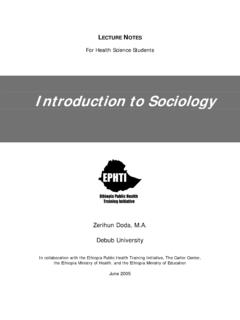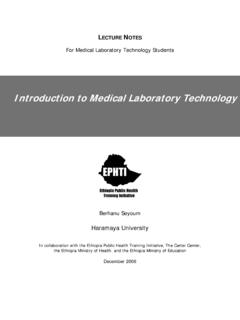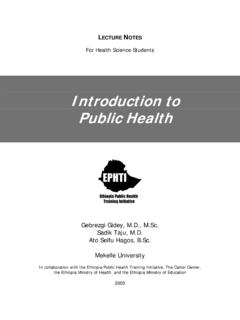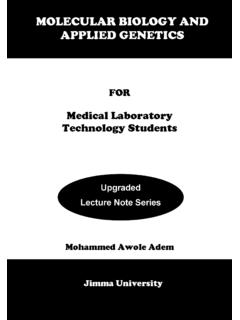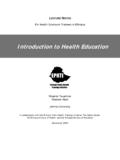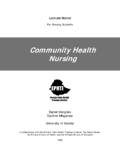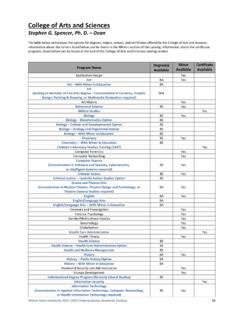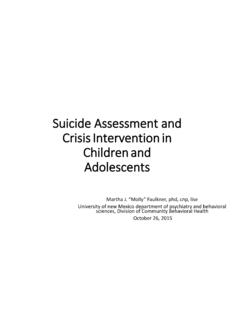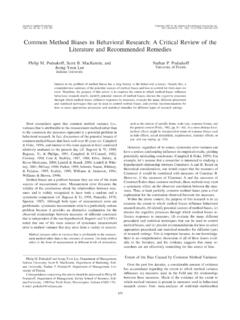Transcription of Introduction to Sociocultural Anthropology
1 LECTURE NOTES For Health Science Students Introduction to Sociocultural Anthropology Zerihun Doda, , Social Anthropology Debub University In collaboration with the Ethiopia Public Health Training Initiative, The Carter Center, the Ethiopia Ministry of Health, and the Ethiopia Ministry of Education June 2005 Funded under USAID Cooperative Agreement No. 663-A-00-00-0358-00. Produced in collaboration with the Ethiopia Public Health Training Initiative, The Carter Center, the Ethiopia Ministry of Health, and the Ethiopia Ministry of Education. Important Guidelines for Printing and Photocopying Limited permission is granted free of charge to print or photocopy all pages of this publication for educational, not-for-profit use by health care workers, students or faculty. All copies must retain all author credits and copyright notices included in the original document.
2 Under no circumstances is it permissible to sell or distribute on a commercial basis, or to claim authorship of, copies of material reproduced from this publication. 2005 by Zerihun Doda All rights reserved. Except as expressly provided above, no part of this publication may be reproduced or transmitted in any form or by any means, electronic or mechanical, including photocopying, recording, or by any information storage and retrieval system, without written permission of the author or authors. This material is intended for educational use only by practicing health care workers or students and faculty in a health care field. iPREFACE Anthropology is a social science, which studies mankind in its entirety. The term in its literal sense means, study of mankind , as it is a combination of two Greek words, namely, anthropos and logos.
3 Anthropology has gained popularity rapidly within the social/ behavioral sciences circle. Through its various fields of specialization, it offers us great insights into the ways of lives of human societies across time and space. Although the science of Anthropology studies all human societies across time and space, it has conventionally been accepted to associate Anthropology with the study of the societies and problems of the traditional, non-western peoples. Health science students learning this discipline have a great advantage of gaining fresh insights and practical benefits in their personal lives and professional practices. Anthropology along with other sisterly disciplines such as sociology, economics, social psychology, human/ cultural geography, history and political sciences has now become essential component iiof the health and medical sciences curricula in universities and other training institutions abroad.
4 Following this example, similar institutions in Ethiopia have also included them in their curricula. Before going any further, I want to make clear that due to its more relevance to the conditions and contexts of developing societies such as Ethiopia; as well as due to the fact that the new health policy of the country focuses on the social, cultural, behavioral , and related dimensions of health; this teaching material is more of Sociocultural Anthropology , and hence may appropriately labeled as Introduction to Sociocultural Anthropology . These lecture notes on introductory Sociocultural Anthropology are prepared for the health and medical sciences students in institutions of higher learning in Ethiopia. Their purpose is to provide the students with basic ideas and knowledge in the science of Anthropology in general and Sociocultural Anthropology in particular.
5 By learning the materials presented in these lecture notes, it is believed that students will be able to understand and appreciate the basic issues, iiiprinciples and approaches of Sociocultural Anthropology . Students may also gain an indirect benefit of appreciating the social, cultural, and behavioral dimensions of health and disease. Specifically, the main learning objective of Introduction to Sociocultural Anthropology is to familiarize students with the basic ideas, issues, concepts and principles of Anthropology . Students will be able to describe the meaning, scopes, methods, history and uses of Anthropology , and its relations to other disciplines. The students will be also able to appreciate the relevance of Sociocultural Anthropology in their personal and future professional practice.
6 The last chapter on medical Anthropology will particularly help students understand the applications of Anthropology in health/ medical sciences . The lecture notes are organized seven chapters. Chapter One deals with introductory issues such as the definition, history, branches, subject-matter and importance of Anthropology and its relations to other disciplines. Chapter Two deals with major perspectives of Sociocultural Anthropology and research methods. In Chapter Three, the concept of culture is discussed. ivMajor themes and concepts in the Anthropology of culture are introduced in this section. Chapter Four covers topics in kinship, family and marriage. In Chapter Five, the Anthropology of religion is presented.
7 Here, the meaning, forms, functions and medical relevance of religion and its beliefs and practices are discussed. Important other concepts in Sociocultural Anthropology such as cross-cultural issues of gender, ethnicity and race, and their implications for health are raised and discussed in Chapter Six. The last Chapter deals with selected concepts and topics in medical Anthropology . Each chapter begins with learning objectives, ends with a chapter summary and has review questions. Inside the text, there are illustrative boxes, tables and figures which are meant to aid the students in utilizing the notes more effectively. Throughout the text, key terms and concepts are highlighted in bold and they are put in glossary section for easy reference.
8 Important references used in preparing these lecture notes are also cited in the text and they are put in bibliographical section. However, it is advisable to use the lecture notes as complementary materials. Students should refer to vthe textbooks and other references for detailed and richer knowledge. The author wishes an enjoyable and fruitful reading for the students. viACKNOWLEDGEMENTS These lecture notes are prepared with the financial assistance made by the Carter Center. I, thus, first of all wish to thank the Caret Center. I also want to thank the College of Health sciences , Debub University, for giving me the chance to participate in preparing these lecture notes. My appreciation also goes to Ato Alemante Amera, my colleague in the College for his constructive comment on the material, during the intra-institutional review meeting.
9 I also wish to extend my deepest thanks to inter-institutional reviewers Ato Woubshet Demewoz, Jimma University; Ato Abraraw Tesfaye, Gondar University; Ato Fasika Melesse, Defense University College and Dr Mesfin Adissie, Addis Ababa University, Medical Faculty. They have constructively contributed to these lecture notes. Last but not least, I want to express my deep gratitude to the national reviewers: Dr Gebre Yntiso and Dr Teketel Abebe of the Department of Sociology and Anthropology , who spared their precious time to review viithese lecture notes. They have made valuables comments I say, Thank you very much! I finally want to assure all the reviewers who contributed to this teaching material that all of your relevant and precious comments are well taken and incorporated into this final version.
10 Zerihun D. Doffana, MA, Social Anthropology June 2005 viiiTABLE OF CONTENTS Contents Page i Acknowledgements .. iv Table of Contents .. viii List of Illustrative Boxes, Figures and Tables .. xiv CHAPTER ONE: Introduction Learning Objectives .. 1 What is Anthropology ? .. 1 Misconceptions about Anthropology .. 4 Brief History of Anthropology .. 7 Subject- matter and Scope of Anthropology .. 11 Distinguishing Features of Anthropology .. 14 The Sub-Fields of Anthropology .. 17 Physical 18 Sociocultural Anthropology .. 21 Archaeological Anthropology .. 23 Linguistic Anthropology .. 25 Applied Anthropology .. 28 Contributions of Anthropology .. 30 The Relationship of Anthropology to Other Disciplines .. 34 Similarities between Anthropology and Other Disciplines.
